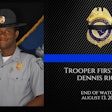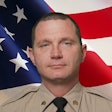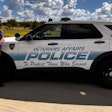When you are in plain clothes, you face certain potential dangers that uniform officers easily avoid.
First, you can easily be misidentified. This can happen if you are working undercover or working as a detective. After all, you work in police operations without a uniform that immediately and instantly identifies you as an officer to both the public and your fellow officers.
You also don't have the luxury of a big duty belt to carry all your gear. So you have a tendency to pack light. That's a tendency that can lead to tragedy. Even if you are wearing a suit and tie on the job, you still need your tools.
The following is some advice that I can offer my plainclothes colleagues still on the job.
Gear and Equipment
Wear Your Body Armor. If you arrest or confront suspects, search buildings, stop cars, or respond to emergency calls, you need to wear body armor. Many types of armor can easily fit under a suit (Hint: you may want to buy work clothes in a slightly larger size to accommodate armor).
There are bullet resistant "investigator" style jackets, "raid" jackets, denim jackets, and photographer's utility vests. Even undercover officers in narcotics or firearms now wear armor whenever practical-and it very often is practical-given the variety of armor available today.
Drive Carefully and Watch the Traffic. An unmarked car, especially one without a roof light bar, is much less visible to other drivers than a marked car, so drive accordingly. If you have only a tiny dashboard flasher or no special lights at all, don't even think of doing pursuits or responding to emergency calls the way you would in a marked car. And please wear a seat belt.
Be careful when you get out of your car on a street or highway, especially at night, since you may be hard for drivers to see. Keep a reflective traffic vest handy in case you have to work at a checkpoint or roadblock, stop traffic at a scene, or stop on the highway shoulder to investigate or collect evidence.
You Need Your Tools. Local laws, agency regulations, and the exact nature of your assignment will affect what gear you can carry. If you work in a non-undercover assignment such as a detective, an investigator, or a plainclothes officer who is not pretending to be a bad guy and you're unlikely to be held or searched by suspects who are trying to figure out whether you are an officer, you need the following, at a minimum:
- A service handgun, not just a tiny .380 autopistol or two-inch barrel .38 revolver.
- A backup firearm.
- A spare magazine if you carry an autopistol. You may not think you need the ammo. But if your gun malfunctions, you may damage your magazine while clearing it and need another good magazine to reload.
- A department portable radio, in case you need to call for help, hear calls for help from your fellow officers, or need to coordinate your actions with other officers. If radio size is a problem, see if your department can get one of the new small portable radios. If your agency won't issue you one but will allow you to use one, consider purchasing one for yourself. Talk to your agency before you buy a radio, so that you get one that's compatible with your agency's radio system. Be sure to test your new radio before you use it, to make certain that it works.
- A cell phone, in case you're caught in a dead spot where your department radio won't work, or you have other radio problems, and need to call for help or contact other officers. Cell phones are very handy in cases where you believe suspects have police scanners or stolen police radios and can monitor your radio transmissions. Note that a cell phone, while valuable, does not replace a department radio, which lets you speak directly with a dispatcher without having to go through 911.
- Defensive tools in addition to your firearm, including OC spray, an expandable baton, or other authorized impact defensive tool. You may need to defend yourself or someone else in a situation where using a firearm isn't appropriate or legally justified. In that case, it's a lot better to have options apart from empty hand strikes or control techniques.
- Handcuffs, both for securing suspects and as a last-ditch defensive tool.
- A flashlight, even in the daytime because you may find yourself in a dark basement, on a dark stairway, or searching for evidence hidden in the dark interior areas of a vehicle. A flashlight can certainly help your shooting in low-light conditions but, more importantly, it helps you decide whether to shoot at all. A flashlight can be vital for target identification, in other words figuring out who is and isn't a deadly threat.
[PAGEBREAK]
Avoid Mistaken Identity
Identify Yourself When You Can Safely Do So Before Taking Enforcement Action. When you aren't properly identified, you increase tvhe risk that someone will mistakenly svhoot you, thinking you're an armed criminal.
A suspect might shoot you. Of course, all too many criminals would shoot a police officer rather than be arrested. There are other suspects who wouldn't intentionally shoot a police officer but would shoot someone they think is a criminal. Many criminals who resist arrest or shoot plainclothes officers often claim that they didn't know that the people they shot were police officers.
Other officers might shoot you, especially if they are from another precinct, unit, or agency, or even from another jurisdiction, and don't know who you are.
A lawfully armed citizen might shoot you, thinking you're a burglar or street robber.
When you remain unidentified, the people you deal with-whether armed or not-may try to run or resist you, which can be dangerous for you and them.
When you can, say who you are and show who you are. Don't just say that you're a police officer; show your badge, shield, ID or credentials. Wear a raid jacket when possible. In a noisy or stressful situation, someone may not hear or understand your spoken ID or warning.
If you are challenged by uniformed or identified officers who don't know who you are, do what they say. In any confrontation between officers, the uniformed or identified officer is in charge. Period.
Don't Stop Cars or Search Buildings Unless You Really Have To. Ideally, if you have to stop a car, do it together with uniformed officers in a marked vehicle or call uniformed officers to the scene after you pull the car over so that the person stopped would know you're law enforcement personnel. If that's not possible, have identification out, wear a raid jacket or other identifying clothing, and clearly identify yourself to the people you stop. If there is a problem or question about your identity, have a uniformed unit respond.
Searching a building can be exceptionally dangerous in plain clothes. If someone calls 911, thinking you're an armed burglar or robber, responding uniformed or plainclothes officers may come searching for you, guns drawn. If you must search a building in plain clothes, it's far safer for each plainclothes officer to search together with a uniformed officer. And each plainclothes officer should wear a raid jacket, cap, or other identifying garment.
Inform Your Fellow Cops That You Are Working In Their Area. Make sure that the agencies where you plan to work, including local precinct, district, and division officers, know that you'll be working in plain clothes and when and where you'll be. It doesn't hurt to go by some uniform roll calls to introduce yourself, thank the officers for their help, and ask them to contact you if they get any information of interest to you.
Don't Sneak Around to Crimes in Progress Without Telling Anyone. When a heavy call comes over the air, you may want to be first on the scene for a chance to capture a robber or burglar. But if other responding officers don't know that you're there, you may be mistaken for an armed suspect and possibly shot.
Tell the radio dispatcher and other units whenever you respond to a call and be very careful when you get there.
Get Help When You Need It. Ask for help from SWAT, emergency services, and regular uniformed personnel when making high-risk arrests or executing high-risk search warrants.
Complacency Kills
Never Let Your Guard Down. Someone you arrest for a misdemeanor warrant might have a string of felony convictions, and not want to go back to prison. Check a suspect's prior arrest and conviction record before you arrest him, when you can legally do so.
The non-violent suspect you've arrested before without incident may now be drunk or on drugs and violently unstable. Some arrests or confrontations may be "high risk," even if you don't know it. So take every arrest or confrontation seriously.
Carefully Search and Secure Prisoners. Rear handcuff and search all prisoners before putting them in your vehicle. If you have to move quickly, search the areas readily accessible by handcuffed prisoners, such as the rear waistband of their pants. Thoroughly search prisoners again when you reach your destination. Do not leave prisoners unattended, no matter how well you have secured them. Make sure prisoners can't access areas where firearms or other potential weapons are stored.
Plainclothes work carries its own special risks, but if you follow the recommendations above, you can help reduce those risks.
Adam Kasanof retired from the NYPD as a lieutenant, and is also a lawyer. However, nothing in this article constitutes legal advice. You can contact him through David Griffith at david.griffith@PoliceMag.com.












